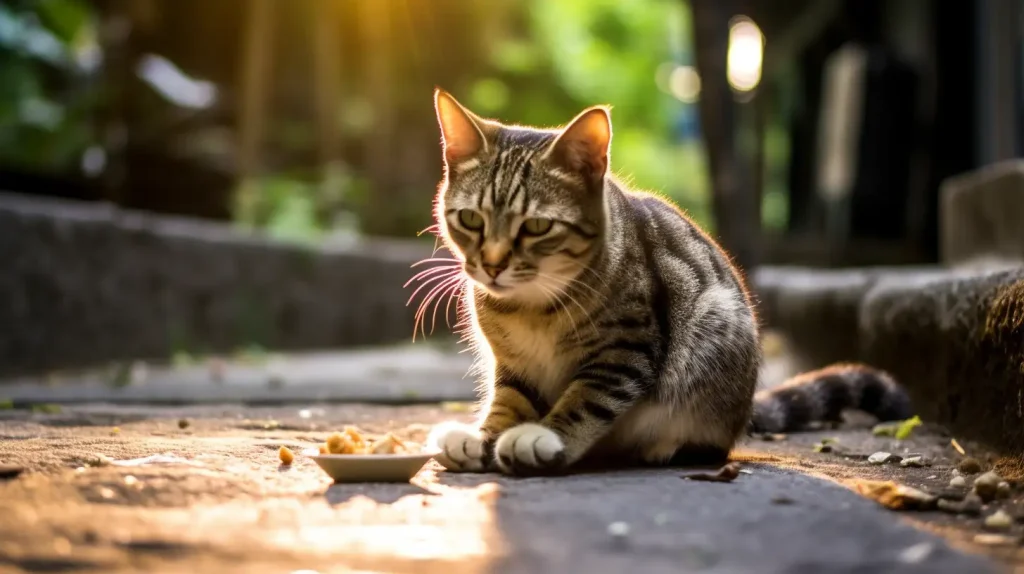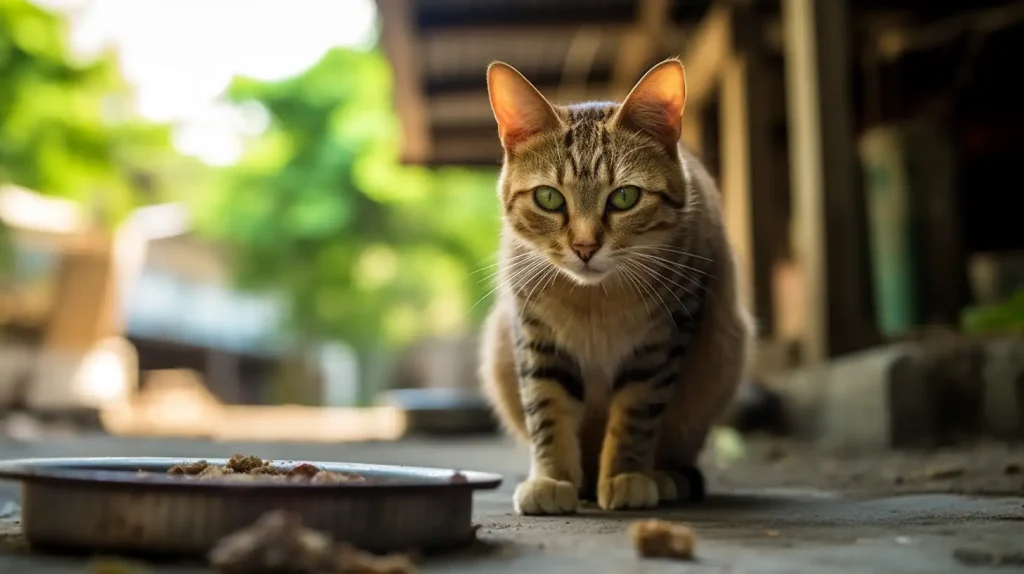Table of Contents
I am used to giving rock-solid, black-and-white advice regarding stray cats. I cannot do that on the topic of knowing how to tell if a stray cat is hungry.
The big issue here is that cats can be very difficult to read at times, especially if you are not the owner of the cat in question. Unless you are intimately familiar with the behavior of a stray cat in your neighborhood, you may not see the signs of hunger. You might also confuse something you see as a cry for food when it really isn’t.
This guide will discuss a number of things that might be able to point you in the right direction. But first, let’s talk about what happens when a cat does not eat or drink frequently enough.
Daily Food Requirements for Cats
To begin with, the average adult house cat needs upwards of 240 calories per day. This calorie count is roughly equivalent to just under 1 cup of dry food or a 6-ounce can of wet food. The key is that a cat should get a balanced diet that provides these calories alongside essential nutrients. This includes a combination of proteins, fats, carbohydrates, vitamins, and minerals. The distribution of these nutrients and their amounts may vary based on the age, size, and health condition of the cat.
Breakdown of Nutrients Required by Cats
- Proteins: Cats are obligate carnivores, meaning they require a diet high in animal-based protein. Proteins supply essential amino acids, which are vital for growth, tissue repair, and overall health. The protein requirement for adult cats is approximately 26% of their total dietary intake, while kittens require even more.
- Fats: Fats provide a concentrated source of energy, supply essential fatty acids, and assist in nutrient absorption. They are essential for healthy skin and fur, and support brain and eye development in kittens. Adult cats require at least 9% fat in their diet.
- Carbohydrates: While cats don’t have a specified requirement for carbohydrates, some can be beneficial for energy production. However, a diet too rich in carbohydrates can lead to obesity and other health issues, so it’s important that they don’t constitute too large a portion of the cat’s diet.
- Vitamins and Minerals: These are needed in small but significant quantities. They play various roles in a cat’s body, from bone formation (calcium and phosphorus) to blood clotting (vitamin K) and vision (vitamin A). Taurine, an essential amino acid, is especially important for cats, as deficiency can lead to serious health issues like heart disease and blindness.
Nutritional Needs Based on Age, Size, and Health Condition
A cat’s dietary needs can change throughout its lifetime and vary based on its size and health condition. Kittens require more calories per pound of body weight than adult cats due to their rapid growth and high energy levels. They also need a diet high in protein and certain nutrients like calcium and phosphorus for bone development.
Senior cats, on the other hand, may need fewer calories but more high-quality proteins and certain nutrients to support aging organs and maintain muscle mass. Overweight cats may require a diet low in fat and carbohydrates but high in fiber to promote weight loss while still feeling satiated.
Certain health conditions can also affect a cat’s dietary needs. For instance, cats with kidney disease often require a diet lower in protein and phosphorus. Diabetic cats may benefit from a high-protein, low-carbohydrate diet. It’s always important to consult a vet when managing a cat’s health condition through diet.
The Risk of Inadequate Nutrition
If a cat goes more than a couple of days without eating, it begins to lose muscle mass. The risk of fatty liver disease, a condition that can prove fatal if left untreated, also goes up. If a cat doesn’t have access to water, it can quickly become dehydrated, leading to potentially life-threatening complications within two or three days.
Stray cats often face these risks. Although they may try to hunt for food, the success rate for domesticated cats hunting is roughly 32%. However, they only eat about 20% of the prey they actually kill. So, in reality, a hunt ends in a consumed meal only about 9% of the time. If a stray cat has no access to food and water, it likely won’t last long outdoors. Recognizing the signs of hunger in these cats is therefore vital.
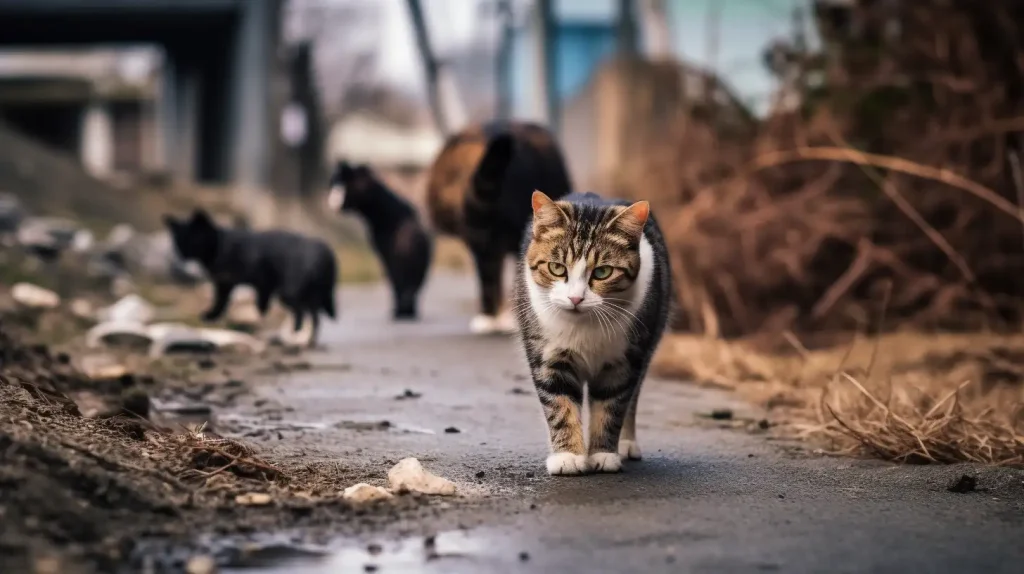
Cat Behavior and Communication
Cats, like all creatures, have their unique means of communication. Their methods extend beyond the familiar meows, purrs, and hisses. When it comes to conveying their thoughts and emotions, cats employ a combination of vocalizations, body language, and behavioral cues.
Vocalization
Vocalizations are among the most common forms of feline communication. From gentle purrs to urgent meows, every sound a cat makes serves a specific purpose. For example, a soft purr usually signifies contentment, while a high-pitched, persistent meow could indicate hunger or distress.
Body Language
In addition to vocal cues, cats use body language extensively to communicate. The position of their tail, ears, and even their whiskers can reveal much about their current emotional state. A relaxed, upright tail generally signals a content cat, while flattened ears might indicate fear or aggression. Observing your feline’s body language can help you gauge its mood and respond appropriately.
Behavioral Cues
Behavioral cues, such as kneading, scratching, or rubbing against objects (or people), can also provide insights into what a cat is trying to communicate. For instance, when a cat rubs against a person, they’re typically marking their territory and expressing comfort and familiarity. A cat kneading with its paws often reflects deep contentment, reminiscent of its kittenhood.
Understanding cat behavior and communication allows you to better interpret what a cat might be trying to express. Whether it’s a resident pet or a stray in your yard, reading these signals can help you to respond effectively to their needs. In the case of strays, a correct interpretation could mean the difference between a cat going hungry or receiving the care it needs.
Listen to the Cry
Cats meow in different ways to communicate different messages. If you own a cat yourself, you are likely familiar with what your pet is trying to communicate based on the sound. Stray cats communicate the same way. So listen to what the animal’s cry sounds like.
An unusually high-pitched cry is often indicative of hunger. If you see this behavior in a stray cat, step back and observe for a few minutes. A hungry cat will continue persistently crying at a higher-than-normal pitch. The cat might even come up to you and aggressively rub against your legs to get your attention. Of course, this would require you to be outside at the same time.
Another thing you can listen for is the length of each cry. The hungrier the cat is, the more persistent its cries will be. Each cry will be comparatively long, almost as if the animal is wailing. This is an important distinction. High-pitched cries may not be a sign of hunger if they occur only in short bursts and without any pattern of regularity.

Pay Attention to the Cat’s Movement
If you were dealing with an indoor cat that was your pet, you would observe a definite pattern of movement in relation to cries of hunger. Not only would the cat let out that persistent high-pitched cry, it would also rub against your legs and then pull away as though it were trying to lead you somewhere. Follow the cat and you will discover that it was trying to lead you – right to the food bowl.
A stray cat will not necessarily have a food bowl to lead you to. But let’s assume the animal has found temporary shelter somewhere in your yard. The cat will think of that shelter as home and, hopefully, a possible place for food too. If you notice the animal appearing to want to lead you somewhere, there is a good chance it is hungry.
Comparative Signs of Hunger Between House Cats and Strays
In understanding the comparative signs of hunger between house cats and strays, it’s critical to keep in mind the different environments and contexts in which these two groups operate. While both will demonstrate similar fundamental behaviors when they’re hungry, the nuances can reveal their domestic or stray status.
A house cat, for instance, operates in a controlled environment where meals are regularly provided. When hunger pangs strike, these felines typically resort to attention-seeking behaviors like persistent meowing, nudging their human companions, or pacing around their food bowl. They may also demonstrate a sudden surge in energy, becoming unusually active or playful as a way to signal their hunger.
In contrast, stray cats, having to fend for themselves in an unpredictable environment, often display different hunger signs. They are less likely to engage in attention-seeking behaviors with humans, especially if they’re not used to human interaction. Instead, their hunger may manifest in more desperate ways. For instance, they might be seen scavenging in trash bins or exploring human habitats more boldly in search of food. Their cries may also sound more distressed or urgent than those of a house cat.
It’s also important to note the physical signs of prolonged hunger, which are more likely to be evident in stray cats. Gaunt appearance, dull coat, sunken eyes, and visible loss of weight are serious indicators that the cat has been unable to find sufficient food for quite some time.
Keep in mind, though, that every cat is an individual. What may be a sure sign of hunger in one cat may not be in another. It’s all about observing the context and recognizing these patterns over time. Paying attention to these differences can not only help in determining whether a cat is hungry, but also in understanding their status – whether they’re a stray or a pet who has ventured outdoors.
Look for Signs of Malnutrition in the Cat
If you are still not sure based on the animal’s cry and pattern of movement, you can try to get close enough to look for signs of malnutrition. Remember what we said earlier: a cat that has not eaten for several days will begin to lose muscle mass. You’ll notice that it looks slightly gaunt with patches of loose skin around the belly and legs.
An extremely hungry cat also won’t have that typical feline look on its face. The eyes may look sunken and the coat a bit dingy. The cat might also demonstrate signs of lethargy. If you suspect malnutrition, put a little dab of something on your finger and hold it out just to see how quickly the cat comes running. If the animal takes the morsel then persistently continues licking your finger even though there’s no more food, there is a good chance it’s hungry.
Preventing Malnutrition in Stray Cats
Malnutrition is a serious concern for stray cats. If you’ve identified that a stray cat in your area appears undernourished, there are several steps you can take to help improve its situation.
Providing Appropriate Food
The first consideration is the type of food to provide. As mentioned above, cats are obligate carnivores, meaning their bodies require a diet high in protein to thrive. To meet this need, provide wet or dry cat food, ideally one that is specifically formulated for adult cats. This type of food contains the right balance of nutrients, vitamins, and minerals. Feeding cats human food or dog food isn’t advised due to insufficient nutritional content and potential harmful ingredients.
Also, if the cat is extremely underweight or weak, they might struggle with hard, dry food. In such cases, wet food could be more appropriate. And remember, clean, fresh water should always be made available alongside the food.
Legal Considerations
However, before you start feeding stray cats, it’s important to be aware of local regulations. Some municipalities have specific laws about feeding stray or feral animals. You may need to check with your local animal control office or a local animal welfare organization to understand the laws in your area.
Partnering with Local Animal Welfare Organizations
Another crucial part of preventing malnutrition in stray cats involves the assistance of local animal welfare organizations. These groups often have programs aimed at supporting strays, such as Trap-Neuter-Return (TNR) initiatives. Through such programs, stray cats can be trapped, vaccinated, neutered, and returned to their territory, reducing the risks of disease and overpopulation.
Taking action to prevent malnutrition in stray cats is a compassionate response, but it is essential to approach the situation responsibly. It’s not only about feeding a stray cat, but also understanding and addressing the broader issues that contribute to the presence of strays and their overall well-being.
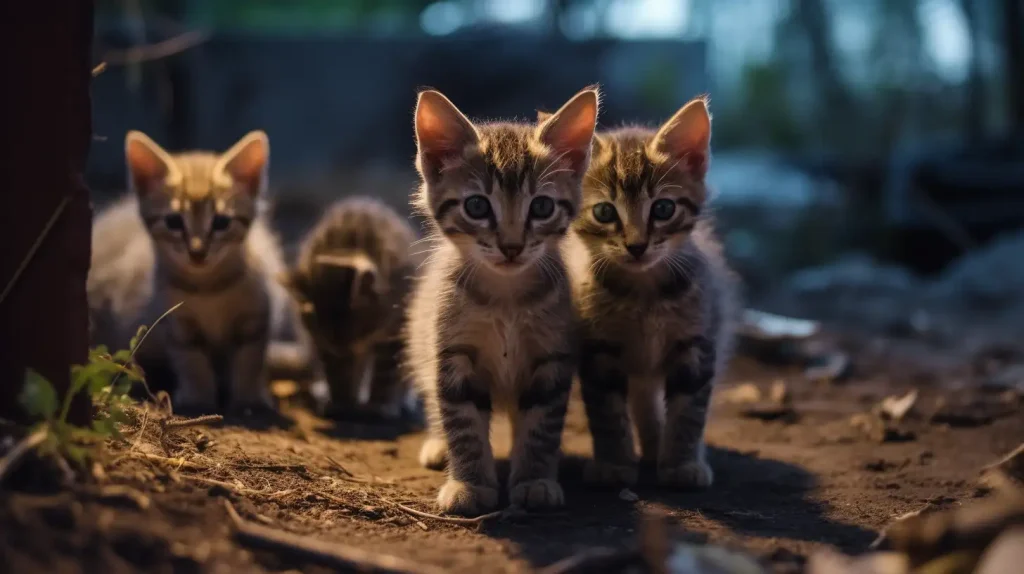
Check Your Trash Receptacles
A stray cat that hasn’t eaten in a while will attempt to hunt. Numerous failures will eventually put the animal in a desperate situation, leading it to consider any possible food source available. What does this mean to you? It means you should check your trash receptacles. Trash is not a cat’s first choice, but it will do in times of hunger. Signs that your trash has been disturbed are indicative that some animal has tried to get at it. Perhaps it’s the stray cat.
You Can’t Know for Sure
Now we arrive at the hard part that people don’t like to talk about. Here it is: there is no way you can know for sure whether a stray cat is truly hungry. As was mentioned earlier, cats are complicated creatures that can be difficult to read. What you perceive as hunger may be something entirely different. What you perceive as just an attempt to be friendly could actually be a cry for food.
One of the biggest difficulties in determining whether a cat is hungry is having to consider that maybe you’re dealing with outdoor cat instead a stray. Remember that outdoor cats are actually pets that prefer to spend their days out and about wandering around.
You might be dealing with an outdoor cat that just happens to be extremely friendly. It may approach you, meowing incessantly to let you know it’s not a threat. The cat might rub around your legs and attempt to get you to bend over and pick it up. You might perceive the combination of meowing and leg rubbing as a cry for food when, in fact, the cat is just being sociable.
In the absence of any definitive signs of hunger, you only have a few choices:
- Ignore – You can ignore the cat in hopes that it is both not hungry and willing to move on if you fail to respond. This can be a risky strategy if letting a hungry cat go hungry would bother you.
- Feed – You can feed the cat immediately and trust you’re doing the right thing. If the cat is a stray, the strategy could mean you end up with a friend for life. If you are dealing with an outdoor cat, it will probably not make a lot of difference to feed the animal just once. It will move along in due course.
- Test – Your third option is to put out just a little bit of food to see what happens. If the cat isn’t truly hungry, it may eat just a little bit before moving on. A hungry cat will quickly devour the food and then beg for more.
Understanding the Impact of Feeding Stray Cats
While our compassionate instincts may lead us to provide food for stray cats, it’s important to comprehend the potential consequences of our actions.
Impact on Local Wildlife
Feeding stray cats can inadvertently disrupt the balance of the local ecosystem. Cats are natural hunters and their predation can play a role in controlling the population of various small creatures. However, when well-meaning individuals provide regular food sources for these cats, the cats’ hunting instincts remain active despite their hunger being satiated. This leads to ‘surplus killing,’ where the cat kills more prey than it can consume, causing a decline in local wildlife populations, including birds, rodents, and reptiles.
Creating Dependence on Human Food
Moreover, regularly feeding stray cats can establish a dependence on human-provided food. While we may think we’re offering a convenient food source, it’s important to remember that many human foods are not nutritionally balanced for a cat’s diet. This can lead to obesity and other health problems. Additionally, a dependence on human food can reduce a cat’s ability to forage and fend for themselves, leaving them vulnerable if their human food source becomes unavailable.
Potential for Overpopulation
Perhaps one of the most significant impacts of feeding stray cats is the potential for overpopulation. Without intervention in the form of neutering or spaying, a small population of strays can rapidly grow. Stray cats often face challenging living conditions, and overpopulation exacerbates these challenges by increasing competition for resources and spreading diseases more quickly.
Therefore, while feeding stray cats might seem like an act of kindness, it’s essential to consider these wider implications. As an alternative, you could consider supporting local animal shelters or cat-specific charities that provide medical care, shelter, and attempt to rehome stray cats. This way, you’re still helping stray cats but in a way that manages their impact on local ecosystems and mitigates the issues of overpopulation and dependence on human food.
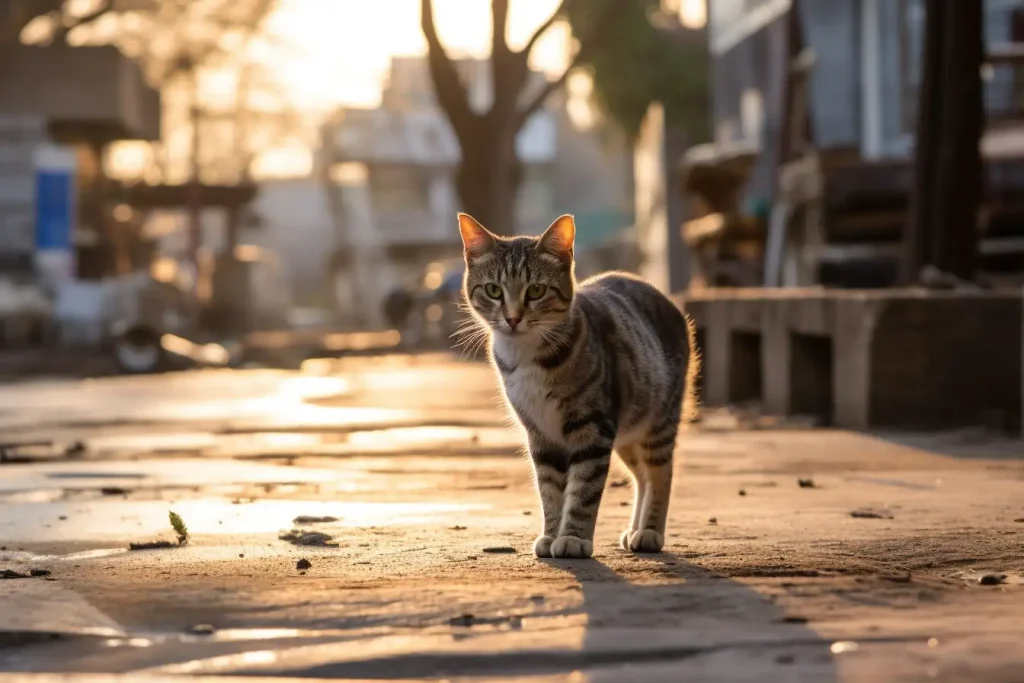
When Healthy Cats Are Hungry
Let’s take a moment to delve into a unique situation – encountering an outdoor cat that is healthy but exhibits persistent signs of hunger. This scenario can often lead to mistaken identities, where a pet cat is mistaken for a stray due to its persistent hunger cues.
While it may seem abnormal, there are legitimate reasons why a perfectly healthy cat might display such insatiable hunger. One of the prime reasons relates to nutrition. It’s a lesser-known fact that cats, being obligate carnivores, don’t thrive well on plant-based diets. Their digestive systems are specifically designed to process meat-based proteins. Therefore, an outdoor cat that isn’t getting enough meat-based proteins from its diet might not be receiving adequate nutrition, leading to a constant state of hunger.
Medical Aspects
Digging deeper into the medical aspects, several health conditions can also lead to chronic hunger in cats. For instance, hypothyroidism, a condition where the thyroid gland produces insufficient amounts of certain crucial hormones, can result in an increased appetite in cats. Despite eating more than usual, affected cats may experience weight loss and other symptoms due to the inefficient conversion of food into energy.
Feline diabetes is another common ailment that can lead to excessive hunger. Similar to diabetes in humans, this condition occurs when a cat’s body cannot produce enough insulin or fails to use insulin effectively. This results in elevated sugar levels in the cat’s bloodstream, leading to increased hunger as the body tries to compensate for the perceived lack of energy fuel.
In some cases, intestinal conditions, such as inflammatory bowel disease (IBD) or parasites, can interfere with the absorption of nutrients from the food the cat consumes. Even if the cat eats regularly, these conditions can prevent it from getting enough nutrition, leading to constant feelings of hunger.
Patterned Behavior
Lastly, it’s worth noting that cats can exhibit patterned behavior. Cats are creatures of habit and are highly attuned to their routines. For instance, a pet cat used to being fed at the same time every day might show signs of hunger if it finds itself outdoors around its usual feeding time. In such cases, the cat may display the typical high-pitched cry and leg rubbing behavior, which you could interpret as signs of starvation. However, it’s just the cat trying to ensure its mealtime schedule is observed.
Diseases and Health Issues in Stray Cats
Stray cats, due to their uncontrolled environments and possible lack of veterinary care, can be susceptible to various health issues and diseases. These conditions not only affect the wellbeing of the cat but may also pose risks to other pets or even humans.
Feline Immunodeficiency Virus (FIV) and Feline Leukemia Virus (FeLV)
Two of the most prevalent viral diseases in stray cats are Feline Immunodeficiency Virus (FIV) and Feline Leukemia Virus (FeLV). Both conditions are contagious among cats and can lead to severe health complications. FIV, akin to HIV in humans, primarily affects a cat’s immune system, making them vulnerable to a host of secondary infections. FeLV, on the other hand, is a retrovirus that can result in an array of health issues, including anemia, immune suppression, and even cancer.
Parasitic Infections
Another common health concern for stray cats is parasitic infections. Fleas are one of the most widespread parasites affecting stray cats, which can lead to dermatitis, tapeworm infestation, and anemia. Ear mites, tiny creatures living in the cat’s ears, can cause intense itching and inflammation, often leading to ear infections. Internal parasites, such as roundworms, hookworms, and tapeworms, can pose severe health problems, including digestive disorders, weight loss, and overall poor health condition.
Rabies
Rabies, a highly contagious and potentially fatal disease that affects the central nervous system, is also a risk in stray cats. It’s crucial to note that rabies can be transmitted to humans and other pets through a bite from an infected cat. While the disease is relatively rare, its severe impact on health warrants attention.
Understanding these diseases can help us comprehend the vulnerability of stray cats and the potential risks involved. It emphasizes the importance of seeking professional veterinary intervention when dealing with strays and underscores the need for responsible stray cat management.
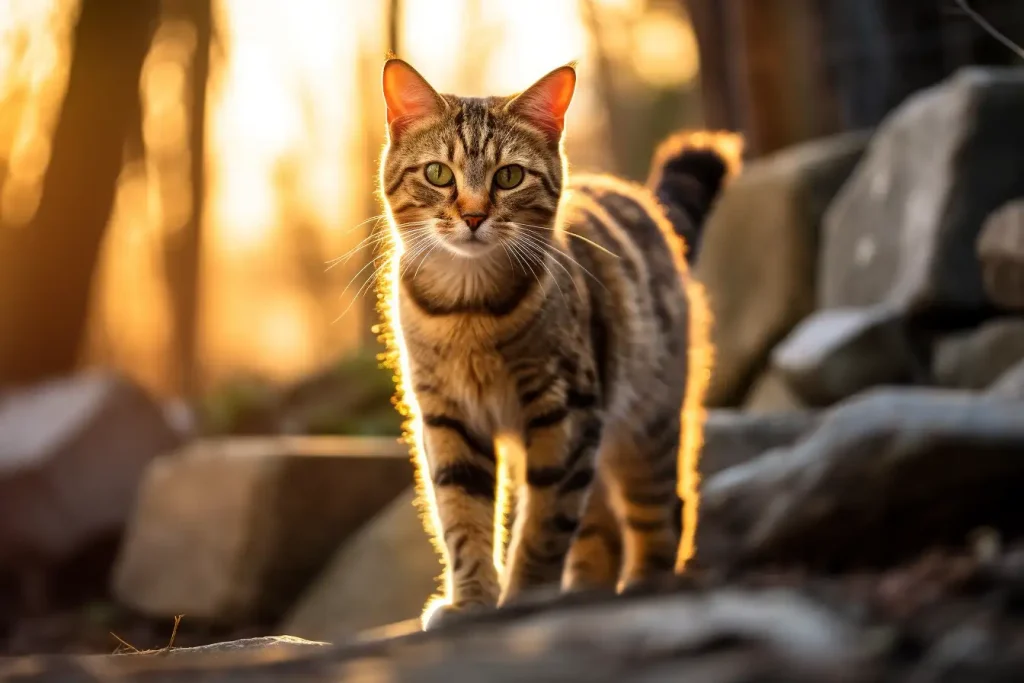
When A Cat is Truly a Stray
Even healthy strays may consistently be hungry for the same reasons listed above. However, before proceeding with any action, it’s vital to determine whether the cat you’re dealing with is genuinely a stray or another category such as a feral cat or an outdoor pet. Each of these groups has distinct behaviors and needs, hence it is important to understand their differences to provide the appropriate help.
Stray Cats
Stray cats are often pets that have been lost or abandoned. They are accustomed to human interaction and are generally friendly. You can recognize them by their demeanor; they may approach you or other people, seem comfortable in human presence, and show signs of previous domestication like remnants of a collar or evidence of spaying or neutering like a clipped ear. They might appear well-groomed, though this can change if they’ve been stray for a long time.
When dealing with a stray cat, remember that feeding it will likely cause the animal to view you as its new caretaker. This is not to suggest you should not feed the cat, but rather to prepare you for potential outcomes. If the cat sticks around after feeding, consider capturing it safely and bringing it to a veterinarian for a thorough medical exam. A veterinary visit could even help identify the animal’s original owner.
Feral Cats
Feral cats differ from stray cats in that they are typically born in the wild and have had minimal human interaction. They are often very cautious, if not outright fearful of humans. They will likely not approach people and tend to hide or stay distant during the day, coming out mostly at night. Feral cats often live in groups or colonies, so if you notice multiple cats together, they could be feral.
It’s important to note that feeding feral cats can result in them becoming reliant on you for food, potentially leading to an increase in the feral cat population in your area. It’s best to contact a local trap-neuter-return (TNR) group who can help ensure the feral cats are neutered and maintain a healthy life without contributing to the overpopulation of cats.
Outdoor Cats
Outdoor cats are domesticated pets that are allowed by their owners to roam freely outside. They are often well-fed and well-groomed, reflecting a home care routine. They may also wear collars or other identification. Despite their roaming, they usually have a territory around their home they don’t stray far from.
Outdoor cats are generally well taken care of by their owners and usually do not require intervention unless they appear injured or sick. If you’re concerned, it’s best to try and contact the owners or local animal control services before taking any further action.
How to Help a Stray Cat
When you stumble upon a stray cat that tugs at your heartstrings, it’s natural to want to assist it in any way possible. But how do you go about that? Here’s a step-by-step guide to aid you in this process.
Step 1: Verify if the Cat is Indeed a Stray
First and foremost, you need to ensure that the cat is indeed a stray. Keep an eye out for a few days to check if the cat consistently appears in the same area, showing signs of being homeless. Often, pet cats allowed outdoors by their owners are mistaken for strays. A stray cat will likely appear less groomed, possibly malnourished, and might be wary of humans, although not as much as a feral cat.
Step 2: Safely Capturing the Cat
Once you’ve determined that the cat is indeed stray, the next step is to safely capture it. Approach with caution as a scared cat might behave unpredictably. Offering food might encourage the cat to come closer. You can then try to coax it into a carrier. However, if the cat is too wary or aggressive, consider contacting a local animal control agency or a professional cat rescuer for assistance.
Step 3: Veterinary Care
Once you’ve managed to capture the stray cat, it’s crucial to take it to a veterinarian for a check-up. Stray cats can have a variety of health issues, including malnutrition, parasites, injuries, or diseases. The vet will be able to administer necessary vaccinations and treatments. Additionally, they can also scan for a microchip to see if the cat is a lost pet.
Step 4: Consider Your Options – Adoption, Rehoming, or Fostering
Finally, consider your options. If you’re ready for a new feline family member and the cat’s temperament is suitable, you might consider adopting it. Alternatively, you can look into rehoming the cat. This could be through friends, family, or a reputable cat adoption agency. If these options aren’t feasible, fostering the cat temporarily while a permanent home is sought can also be an act of immense kindness. Remember, even providing a warm, safe, temporary space for the cat until a shelter can take them in is a great help.
How to Know if a Stray Cat is Hungry – Conclusion
Understanding the potential health risks associated with stray cats, including parasitic infections, feline diabetes, and rabies, highlights the importance of seeking professional veterinary help when caring for these animals. By recognizing the signs of chronic hunger in stray cats, we can help identify potential health problems and work to ensure they receive the necessary nutrition and care. Adopting a stray cat or fostering one temporarily until they find a permanent home can also be an act of great kindness. Ultimately, responsible stray cat management requires a community effort to ensure their safety, well-being, and quality of life.
Key Takeaways
- Stray cats require a balanced diet that provides essential nutrients, including proteins, fats, carbohydrates, vitamins, and minerals.
- The protein requirement for adult cats is approximately 26% of their total dietary intake, while kittens require even more.
- Fats provide a concentrated source of energy, supply essential fatty acids, and assist in nutrient absorption.
- There is no way to know for sure whether a stray cat is truly hungry, as cats can be difficult to read and their cues can be mistaken for hunger.
- Providing human foods to stray cats can lead to obesity and other health problems, as many human foods are not nutritionally balanced for a cat’s diet.
- Internal parasites, such as roundworms, hookworms, and tapeworms, can pose severe health problems in cats, including digestive disorders and weight loss.
- Rabies is a highly contagious and potentially fatal disease that affects the central nervous system and is a risk in stray cats. Seek professional veterinary intervention when dealing with stray cats to ensure their safety and well-being.
- Adopting or fostering stray cats can be an act of kindness, but it’s important to consider whether you can provide proper care, nutrition, and a safe environment for them.
- Responsible stray cat management requires a community effort to ensure their safety, well-being, and quality of life.
- Understanding the potential health risks associated with stray cats can help us comprehend the vulnerability of these animals and the importance of seeking professional veterinary help when caring for them.
COPYRIGHT NOTICE
Please be advised that all images, designs, and creative content on this page are the exclusive property of Stray-Cat-Advice.com and are protected under international copyright laws. The images may not be reproduced, copied, transmitted or manipulated without the written permission of stray-cat-advice.com.
Unauthorized use, distribution, display, or creation of derivative works of any images contained on this site, is strictly prohibited and can lead to legal penalties. We actively monitor for, and enforce, our copyright interests.
If you wish to use any of our images, kindly contact us to seek permission. Respect of copyright is not merely a legal requirement but also an acknowledgement and support of the hard work and creativity that goes into producing them.
Thank you for your understanding and cooperation.
© 2023, stray-cat-advice.com. All Rights Reserved.


